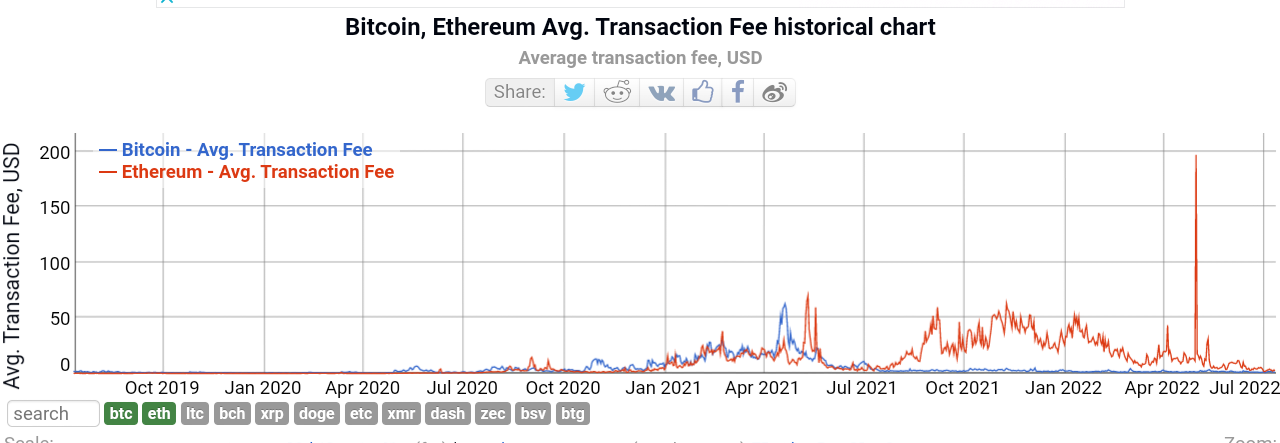Ethereum’s much-awaited “Merge” will not result in a reduction in the cost of sending a transaction over the network, according to DeFi researcher Vivek Raman.
The Merge is intended to shift the Ethereum (ETH) blockchain from the existing proof-of-work (PoW) consensus mechanism to proof-of-stake (PoS). After several delays, the upgrade is now expected to take place sometime between Aug and Nov.
“Proof of stake makes Ethereum issuance lower, energy consumption lower, security (cost to attack the chain) higher, and makes Ethereum more economically sustainable,” Raman told Be[In]Crypto.
Sponsored“However, none of this relates to fees. Fees are a function of blockspace demand. If people want to use ETH all at once, fees will still go up.” Earlier, Raman wrote on Twitter that “post-Merge, Ethereum layer one fees will not come down.”
Layer 2 tech to drive fees lower
Ethereum users have had to pay through the nose to perform a transaction on the network. It cost an average $197 to get a transaction processed via the Ethereum blockchain on May 1, according to data by Bitinfocharts.
Average ETH transaction fees have since slumped 99% to $2.61 as of July 12. This may be due to a loss of momentum in the decentralized finance (DeFi) economy, as crypto markets crashed following the collapse of the Terra blockchain.
Together with non-fungible tokens (NFTs), DeFi has been one of the biggest drivers of Ethereum gas fees since around July 2020, when it really started to take off.
SponsoredFees are paid each time an ETH transaction is processed and confirmed by a miner, who pockets the fees as revenue.

There has been some expectation from retail investors that the Merge will result in reduced fees. Vivek Raman, the DeFI researcher, explained that those looking for lower fees after the Ethereum network upgrade will have to look elsewhere.
SponsoredRollups will reduce fees
“We do have Layer 2 solutions, called rollups, like Polygon and Optimism and Arbitrum and ZKsync and Starkware, that reduce fees drastically while inheriting the security of ETH. That’s the endgame for users – they will all use rollups,” he said.
Raman’s comments dovetail with Ethereum co-founder Vitalik Buterin sentiments in 2020, who said investors will have to utilize Layer 2 technology to get around the issue of high transaction costs.
“To those replying with ‘gas fees are too high’, my answer to that is ‘well then more people should be accepting payments directly through zksync/loopring/OMG’. Seriously, scaling to 2500+ TPS for simple-payments applications is here, we just need to… use it,” he tweeted at the time.
However, fees on Layer 2 solutions are starting to rise above those on the Ethereum mainnet, as Be[In]Crypto reported recently. The average cost of exchanging tokens on Arbitrum reached more than $6 on June 30, which compared unfavorably with ETH’s $5.36 at the time.
SponsoredRaman: post-Merge Ethereum inflation to drop to 0.22%
In his Twitter thread, Vivek Raman also spoke about Ethereum’s inflation, saying it will drop from 4.3% to 0.22% after the Merge. That is because of a 95% reduction in issuance, which means “95% less ETH that can be sold daily.”
With the network upgrade, he expects that Ethereum will complement Bitcoin’s use cases as “pristine collateral and a store of value.”
“Bitcoin has cemented its narrative as ‘digital gold’ – and that’s great. ETH’s will be both a ‘digital bond’ (staking yield = risk free rate) and DeFi’s main collateral asset,” said Raman, adding:
“Ethereum Merge is one of the most impressive engineering feats in blockchain history. Under a fully PoS regime, ETH will have the economic structure to increase security, scale with Layer 2s, grow its DeFi and NFT platforms, and overtake BTC’s throne.”

